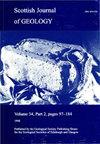New information on the Early Devonian acanthodian Mesacanthus mitchelli from the Midland Valley of Scotland
IF 1.3
4区 地球科学
Q4 GEOLOGY
引用次数: 0
Abstract
Mesacanthus mitchelli is an important taxon in elucidating relationships amongst stem chondrichthyans, being the best known and most abundant of the oldest known acanthodiform acanthodians. Here we note some newly recognised morphological features and describe the histological structure of the endoskeleton and dermal elements. The jaws are preserved as a single layer of irregularly tessellate bone-like mineralisations. A mandibular bone is not present, contrary to previous descriptions. Fin spines have a wide central cavity that is more than half the width at mid-spine level. Prepelvic spines have a very narrow leading edge ridge and a wide open pulp cavity. Head sensory lines are enclosed by a pair of tesserae with a smooth crown, flat base and concave sides, bordering the sensory line canal. The tiny body scales have a relatively large pulp cavity in the embryonic zone. The large size of the eyes relative to the head and body size in Mesacanthus mitchelli, the structure and small size of the scales relative to those of other acanthodians of a similar size, and the wide central pulp cavity in the spines, all indicate that the species is likely to have undergone paedomorphism.苏格兰米德兰谷地早泥盆世棘多目Mesacanthus mitchelli的新资料
mitchelli Mescanthus是阐明茎球粒陨石之间关系的一个重要分类单元,是已知最古老的棘突类棘突亚目中最著名、数量最多的一个。在这里,我们注意到一些新认识的形态学特征,并描述了内骨骼和真皮元件的组织结构。颌骨被保存为一层不规则镶嵌的骨骼状矿化层。与之前的描述相反,下颌骨不存在。鳍棘有一个宽阔的中央空腔,其宽度超过棘中部宽度的一半。骨盆前棘有一个非常狭窄的前缘脊和一个开放的髓腔。头部感觉线由一对光滑的牙冠、平坦的基底和凹陷的侧面包围,与感觉线管接壤。微小的鳞片在胚胎区有一个相对较大的髓腔。Mesacantus mitchelli的眼睛相对于头部和身体的大小较大,鳞片相对于其他类似大小的棘皮动物的结构和较小,以及棘中宽阔的中央髓腔,都表明该物种很可能经历了两性异形。
本文章由计算机程序翻译,如有差异,请以英文原文为准。
求助全文
约1分钟内获得全文
求助全文
来源期刊

Scottish Journal of Geology
地学-地质学
CiteScore
1.70
自引率
0.00%
发文量
10
审稿时长
>12 weeks
期刊介绍:
Although published only since 1965, the Scottish Journal of Geology has a long pedigree. It is the joint publication of the Geological Society of Glasgow and the Edinburgh Geological Society, which prior to 1965 published separate Transactions: from 1860 in the case of Glasgow and 1863 for Edinburgh.
Traditionally, the Journal has acted as the focus for papers on all aspects of Scottish geology and its contiguous areas, including the surrounding seas. The publication policy has always been outward looking, with the Editors encouraging review papers and papers on broader aspects of the Earth sciences that cannot be discussed solely in terms of Scottish geology.
The diverse geology of Scotland continues to provide an important natural laboratory for the study of earth sciences; many seminal studies in geology have been carried out on Scottish rocks, and over the years the results of much of this work had been published in the Journal and its predecessors.
The Journal fully deserves its high reputation worldwide and intends to maintain its status in the front rank of publications in the Earth sciences.
 求助内容:
求助内容: 应助结果提醒方式:
应助结果提醒方式:


